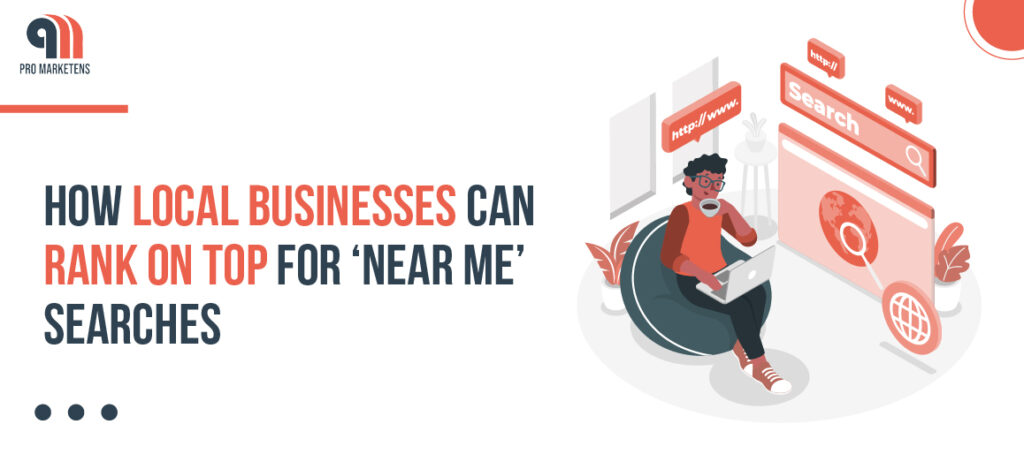The way consumers search for local businesses has evolved significantly. With the widespread use of smartphones and voice-activated devices, “near me” searches have become the norm. These searches are intent-driven, indicating that users are actively seeking products or services in their vicinity.
If you’re a local business owner, optimizing your online presence to rank on top for “near me” searches is essential for driving foot traffic and online sales.
In this blog, we’ll explore effective strategies to help local businesses achieve top rankings for these valuable search queries.
Optimize Your Google My Business (GMB) Listing
The foundation of local search optimization is your Google My Business listing. Ensure your GMB profile is complete, accurate, and up-to-date.
Verify your business information, including your name, address, phone number, and business hours. Add high-quality images and select relevant categories. Encourage customers to leave positive reviews and respond promptly to their queries or feedback.
Local Keyword Optimization
To rank well for “near me” searches, optimize your website and GMB listing with local keywords. Include your city or neighborhood name in your website content, meta descriptions, and GMB description.
For example, if you run a bakery in Los Angeles, use phrases like “Los Angeles bakery” or “best bakery in Los Angeles” to increase your visibility in local search results.
Mobile Optimization
Since “near me” searches are often performed on mobile devices, ensure your website is mobile-friendly. Google prioritizes mobile-responsive websites in its rankings, making it crucial for local businesses to provide a seamless user experience on smartphones and tablets.
High-Quality Content
Create valuable, informative, and engaging content that resonates with your local audience. Write blog posts, articles, or guides relevant to your industry or niche, addressing the needs and interests of your local customers. Google rewards high-quality content that demonstrates expertise, authority, and trustworthiness.
Local Link Building
Building local backlinks can significantly boost your local SEO efforts. Reach out to local business associations, chambers of commerce, and other organizations for opportunities to collaborate and link to your website. Acquiring backlinks from local news outlets or community organizations can enhance your website’s local authority.

Schema Markup
Implement schema markup on your website to provide search engines with structured data about your business, such as your address, phone number, hours of operation, and customer reviews. Schema markup helps search engines understand your content better, leading to more accurate and informative search results.
Consistent NAP Information
Maintain consistent and accurate Name, Address, and Phone (NAP) information across all online platforms, including your website, GMB listing, social media profiles, and local directories. Inconsistent NAP data can confuse search engines and hurt your local rankings.
Customer Reviews and Ratings
Encourage satisfied customers to leave positive reviews and ratings on your GMB listing and other relevant review platforms. Online reviews not only influence potential customers but also play a significant role in local search rankings.
Voice Search Optimization
As more people use voice-activated devices for “near me” searches, it’s vital to optimize your content for voice search. Focus on answering frequently asked questions concisely, as voice search queries tend to be more conversational.
Location Pages
If your business serves multiple locations, create individual location pages on your website. Each page should include unique content, such as location-specific information, testimonials, and customer reviews. This helps search engines understand that you have a presence in multiple areas.
Online Directories and Citations
Ensure your business is listed accurately in online directories and local citations. These listings validate your business information and can improve your local SEO. Be meticulous about your NAP data to maintain consistency across all platforms.
Geotagging Images
Geotagging your images with location metadata can provide an additional signal to search engines about your business’s physical location. This can enhance your visibility for local searches and reinforce your local presence.
Monitor and Analyze Your Performance
Use Google Analytics, Google Search Console, and other SEO tools to monitor your website’s performance. Track changes in rankings, organic traffic, and user behavior. Regularly review the data to adjust your strategy and identify opportunities for improvement.
Local Business Directories
List your business in reputable local directories such as Yelp, Yellow Pages, and TripAdvisor. These platforms can help you reach a broader local audience and improve your online visibility.
Social Media Engagement
Active engagement on social media platforms can positively impact your local search rankings. Share local events, promotions, and community involvement to foster a strong online presence and build relationships with your audience.
conclusion:
Ranking on top for “near me” searches is a key objective for local businesses looking to attract local customers.
By implementing these strategies, you can enhance your online visibility, drive foot traffic to your physical store, and increase online sales. Stay committed to improving your local SEO efforts, and you’ll be well on your way to dominating “near me” search results in your area.





